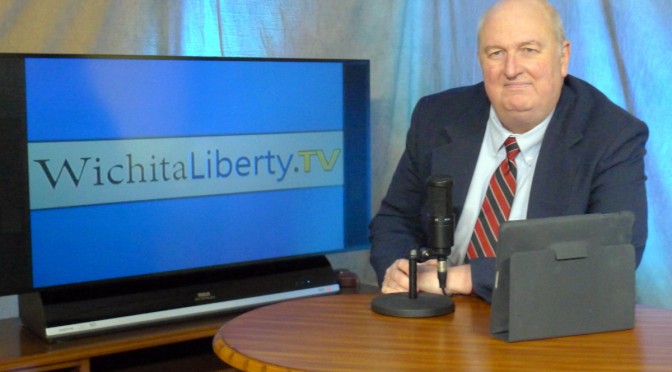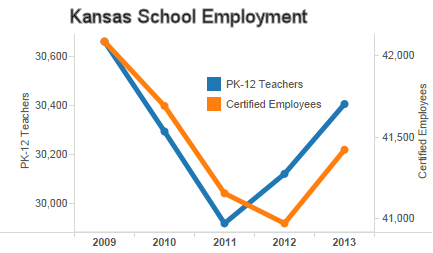
Claims made about Kansas schools don’t match the state’s statistics.
Responding to the State of the State Address delivered by Kansas Governor Sam Brownback, Kansas House of Representatives Minority Leader and gubernatorial candidate Paul Davis provided figures regarding Kansas public schools, telling Kansans: “On top of that, public school class sizes are growing, [and] teachers have been laid off by the thousands.”
Statistics from Kansas State Department of Education, however, show that school employment has rebounded, both in terms of absolute numbers of teachers and certified employees, and the ratios of pupils to these employees.

The story is not the same in every district. But considering the entire state, two trends emerge. For the past two years, the number of teachers employed in Kansas public schools has risen. Correspondingly, the pupil-teacher ratio has fallen. (This ratio is not the same statistic as average class size, but it’s the data we have. Plus, if schools are hiring teachers at a rate higher than the increase in students, we should expect class sizes to fall.)

The trend for certified employees is a year behind that of teachers, but for the last year, the number of certified employees has risen, and the ratio to pupils has fallen.
I’ve created interactive visualizations that let you examine the employment levels and ratios in Kansas school districts. Click here for the visualization of employment levels. Click here for the visualization of ratios (pupil-teacher and pupil-certified employee). Data is from Kansas State Department of Education. Visualization created by myself using Tableau Public.
There’s also this to consider about class size. In 2011 the Center for American Progress released a report about class size reduction in schools and the false promise it holds for improving student achievement. (The False Promise of Class-Size Reduction)
It’s quite astonishing to see CAP cite evidence from Eric Hanushek of the Hoover Institution and Caroline Hoxby of Stanford and Hoover. These two researchers are usually condemned by the public education establishment and bureaucracy, including teachers unions. These are some of the key constituents CAP usually caters to.
In a nutshell, class size reduction produces very little benefit for students. It’s also very expensive, and there are other things we should be doing instead if we really want to increase student achievement.
The report summarizes the important studies in class size reduction. The upshot is that there is only one study showing positive results from class size reduction, and that effect was found only among the early grades. The effect decreased after a few years, even though small class sizes were still used.
The report also notes that class size reduction is very expensive to implement. Because it is, the report says we should look to other ways to increase student achievement, such as policies relating to teacher effectiveness: “The emerging consensus that teacher effectiveness is the single most important in-school determinant of student achievement suggests that teacher recruitment, retention, and compensation policies ought to rank high on the list.”
On teacher quality and teacher effectiveness: When Sandi Jacobs of National Council for Teacher Quality appeared in Kansas a few years ago, we learned that Kansas ranks below average on its policies that promote teacher quality.
In the example she illustrated, third graders who had teachers in the top 20 percent of effectiveness for the next three years went from the 50th percentile in performance to the 90th. For students with teachers in the lowest 20 percent for the same period, their performance dropped from the 50th percentile to the 37th percentile. More on this topic is at Kansas ranks low in policies on teacher quality.
 A letter in the Wichita Eagle accused Kansas Policy Institute of the “destruction of K-12 education.” Following is part of the comment KPI president Dave Trabert wrote in response to the letter. It’s a good recap of what KPI has done the past few years. I’m left to wonder how anyone who cares about Kansas schoolchildren could be opposed to the work KPI has done.
A letter in the Wichita Eagle accused Kansas Policy Institute of the “destruction of K-12 education.” Following is part of the comment KPI president Dave Trabert wrote in response to the letter. It’s a good recap of what KPI has done the past few years. I’m left to wonder how anyone who cares about Kansas schoolchildren could be opposed to the work KPI has done. 

 Considering only base state aid per pupil leads to an incomplete understanding of school spending in Kansas. The Gannon school finance decision reinforces this.
Considering only base state aid per pupil leads to an incomplete understanding of school spending in Kansas. The Gannon school finance decision reinforces this. 








 When comparing Kansas school test scores to those of other states, it’s important to consider disaggregated data. Otherwise we may — figuratively speaking — let the forest obscure the trees.
When comparing Kansas school test scores to those of other states, it’s important to consider disaggregated data. Otherwise we may — figuratively speaking — let the forest obscure the trees.